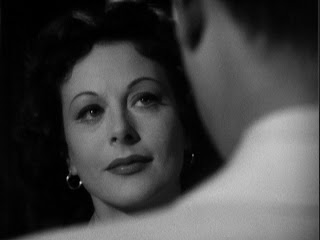I just caught this little-known (to me anyway) quasi-noir on TCM a few days ago. It’s the story of a tough but charming INS agent (John Hodiak), who is sent to bust up an illegal immigration ring in Bautista-era Cuba. Along the way he meets and falls for a mysterious WWII refugee (Hedy Lamarr), at the same time crossing swords with ever sinister bad guy George Macready.
Lady Without Passport is on balance a fun movie : a tasty combination of romance* and film noir, done in the semi-documentary style popular in movies of the late Forties and early Fifties. It has the customary MGM gloss which tends to tone down the noir grittiness, bringing to mind The Bribe by the same studio, which also starred John Hodiak in a similar role (in that film Ava Gardner was the femme fatale; lucky John!). But MGM never had that much success with noir; perhaps the studio was just too civilized to capture the genre’s existential angst. Here the picture has the requisite gloomy look and familiar character types, but lacks the sinister undercurrent and aforementioned existential uneasiness.
Anyway there’s still much to savor in LWP. While clearly not the zenith of either Miss Lamarr’s or John Hodiak’s career, the film nonetheless has a quirky charm that makes it eminently watchable as it anticipates, by a decade, Our Man in Havana, another amiable if not quite memorable film.
Miss Lamarr is beautiful as always, but this was late in her career and she has a worse for the wear look which actually serves the character rather well. Her slinky cigarette girl costume recalls her role in White Cargo as the über jungle temptress Tandelayo (poor John Hodiak didn’t have a chance).
Hodiak is perhaps best-known as the edgy socialist who becomes Talulah Bankead’s romantic interest in Lifeboat. In the noir context he is probably best remembered for Somewhere in the Night. His dusky looks work to his advantage in Havana as he poses as a ... Hungarian. And though not a conventional good-looking leading man there’s plenty of chemistry between him and Hedy. And of course there’s Macready, in a role similar to the character he played in Gilda, as the head of the human smuggling ring. He makes a deliciously effete villain.
But the real star of the film is the all too fleeting on-location atmosphere in pre-Fidel Cuba, in which Havana is presented as a kind of sleepy, benign playground. The result is that it all tends to whitewash the rampant corruption that was going on. Probably the best, and most noirish scene is the racy dance number performed by Nita Bieber in a smoky mambo club -- pretty spicy stuff for the 1950s. There’s also, toward the end of the film, the novel setting of the Florida Everglades where a real jungle, with its own lethal charms, stands in for familiar noirish urban jungle. Also deserving mention is David Raksin’s jazzy Latino score.
The film is both pro INS and relatively sympathetic to the plight of the undocumented alien, giving the story an uncanny timeliness in our current political climate.
Further reading : Ruth Barton, Hedy Lamarr : the most beautiful woman in film, University of Kentucky Press, 2010, pp. 177-179.
Further reading : Ruth Barton, Hedy Lamarr : the most beautiful woman in film, University of Kentucky Press, 2010, pp. 177-179.
* Then again all noirs are, at their core, romances, however offbeat.


